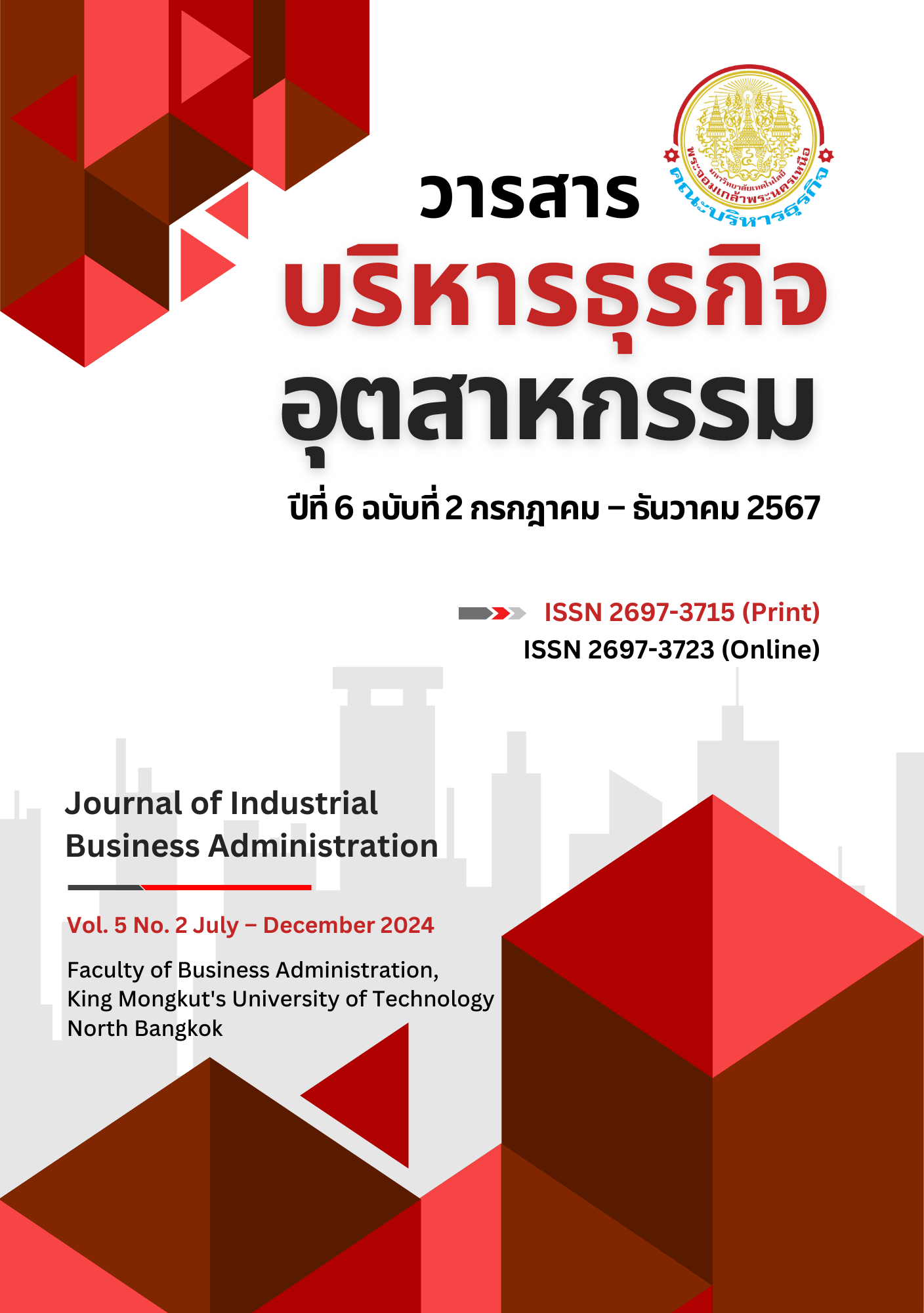ปัจจัยที่มีอิทธิพลต่อความตั้งใจเชิงพฤติกรรมของผู้ใช้บริการแชทบอทบริการด้านการเงิน
คำสำคัญ:
แชทบอทบริการด้านการเงิน, อิทธิพลทางสังคม, อิทธิพลทางการตลาด, ความตั้งใจเชิงพฤติกรรมบทคัดย่อ
การศึกษาปัจจัยที่มีอิทธิพลต่อความตั้งใจเชิงพฤติกรรมของผู้ใช้บริการแชทบอทบริการด้านการเงิน ใช้กลุ่มตัวอย่างในการศึกษาจำนวน 400 คน ที่อาศัยอยู่ในกรุงเทพมหานครและปริมณฑล โดยมีแนวคิดแบบจำลอง คือ แบบจําลองการยอมรับเทคโนโลยี (Technology Acceptance Model: TAM) ซึ่งมีวัตถุประสงค์ คือ (1) เพื่อศึกษาอิทธิพลทางสังคม อิทธิพลทางการตลาด การรับรู้ประโยชน์ ความไว้วางใจ และความตั้งใจเชิงพฤติกรรมของผู้ใช้บริการแชทบอทบริการด้านการเงิน และ (2) เพื่อทดสอบปัจจัยที่มีอิทธิพลต่อความตั้งใจเชิงพฤติกรรมของผู้ใช้บริการแชทบอทบริการด้านการเงิน โดยใช้แบบสอบถามเป็นเครื่องมือในการเก็บรวบรวมข้อมูล จากนั้นทำการวิเคราะห์ข้อมูลเชิงสถิติ ได้แก่ ค่าเฉลี่ย ร้อยละ การกระจายความถี่ และส่วนเบี่ยงเบนมาตรฐาน และทดสอบสมมติฐานทางสถิติ ประกอบด้วย การวิเคราะห์สมการโครงสร้างเชิงเส้น (Structural Equation Modeling: SEM) และการวิเคราะห์อิทธิพลของตัวแปรคั่นกลางแบบอนุกรม (Serial Mediation Variables) โดยผลการศึกษา พบว่า อิทธิพลทางสังคมไม่มีความสัมพันธ์เชิงบวกต่อการรับรู้ประโยชน์ อิทธิพลทางการตลาดมีความสัมพันธ์เชิงบวกต่อการรับรู้ประโยชน์ การรับรู้ประโยชน์มีความสัมพันธ์เชิงบวกต่อความไว้วางใจ อิทธิพลทางสังคมและความไว้วางใจมีความสัมพันธ์เชิงบวกต่อความตั้งใจเชิงพฤติกรรม และอิทธิพลทางการตลาดไม่มีความสัมพันธ์เชิงบวกต่อความตั้งใจเชิงพฤติกรรม
References
Ajzen, I. & Fishbein, M. (1980). Understanding attitudes and predicting social behavior. Englewood, NJ: Prentice-Hall.
Alagarsamy, S., & Mehrolia, S. (2023). Exploring chatbot trust: Antecedents and behavioural outcomes. Heliyon, 9(5).
Beldad, A. D., & Hegner, S. M. (2017). Expanding the Technology Acceptance Model with the Inclusion of Trust, Social Influence, and Health Valuation to Determine the Predictors of German Users’ Willingness to Continue using a Fitness App: A Structural Equation Modeling Approach. International Journal of Human–Computer Interaction, 34(9), 882-893.
Botpress. (2024, 21 August). Key Chatbot Statistics for 2024: Perceptions, Market Growth, Trends. https://botpress.com/blog/key-chatbot-statistics.
Brush, K. (2024, May). Chatbot. Customer Experience. https://www.techtarget.com/searchcustomerexperience/definition/chatbot.
Business & Technology. (2564, 20 ธันวาคม). แชทบอทคืออะไร? ตัวช่วยธุรกิจที่ขาดไม่ได้ในยุค Next normal. Business & Technology. https://aigencorp.com/what-is-chatbot/.
Cham, T. H., Lim Y. M., & Sigala M. (2020). Marketing and social influences, hospital branding, and medical tourists' behavioural intention: Before- and after-service consumption perspective. International Journal of Tourism Research, 24(1), 140-157.
Cheng, X., Zhang, X., Cohen, J., & Mou, J. (2022). Human vs. AI: Understanding the impact of anthropomorphism on consumer response to chatbots from the perspective of trust and relationship norms. Information Processing & Management, 59(3).
Davis, F. D. (1989). Perceived Usefulness, Perceived Ease of Use, and User Acceptance of Information Technology. MIS Quarterly, 13(3).
Deutsch, M., & Gerard, H. B. (1955). A study of normative and informational social influences upon individual judgment. The Journal of Abnormal and Social Psychology, 51(3), 629–636.
Durmaz, Y., Cavus, O., & Jakubowski, G. W. (2023). The Effect of Influencer Marketing on Trust, Trust Tendency and Consumer Purchase Intention: Instagram Example. Research in Economics and Management, 8(1).
Ferreira, D. B., Giovannini, C., Gromova, E., & Schmidt, G. d. R. (2022). Arbitration chambers and trust in technology provider: Impacts of trust in technology intermediated dispute resolution proceedings. Technology in Society, 68.
Goundar, S., Lal, K., Chand, A., & Vyas, P. (2021). Consumer Perception of Electronic Commerce – Incorporating Trust and Risk with the Technology Acceptance Model. https://doi.org/10.5772/intechopen.98419.
Hooda, A., Gupta, P., Jeyaraj, A., Giannakis, M., & Dwivedi, Y. K. (2022) The effects of trust on behavioral intention and use behavior within e-government contexts. International Journal of Information Management, 67.
Howard, M. C. (2020). Sobel Test Formula for Serial Mediation / Sequential Mediation. https://mattchoward.com/sobel-test-formula-for-serial-mediation-sequential-mediation/.
Juniper Research. (2017, May). Chatbots, a Game Changer for Banking & Healthcare, Saving $8 billion Annually by 2022. https://www.juniperresearch.com/press/chatbots-a-game-changer-for-banking-healthcare/.
Kim, J., & Lee, H. (2004). Investgating the effect social influence on information teachnology acceptance.
Kotler, P., & Keller, K. L. (2012). Marketing Management (14th Edition).
Kulviwat, S., Bruner, G. C., & Shuridah, O. A. (2009). The role of social influence on adoption of high tech innovations: The moderating effect of public/private consumption. Journal of Business Research, 62(7), 706-712.
Kurniawan, I. A., Mugiono, M., & Wijayanti, R. (2022). The Effect of Perceived Usefulness, Perceived Ease of Use, and Social Influence toward Intention to Use Mediated by Trust. Jurnal Aplikasi Manajemen, 20(1), 117-127.
Mogaji, E., Balakrishnan, J., Nwoba, A. C., & Nguyen, N. P. (2021). Emerging-market consumers’ interactions with banking chatbots. Telematics and Informatics, 65.
Ong, M. H. A., Yusri, M. Y., & Ibrahim, N. S. (2023). Use and behavioural intention using digital payment systems among rural residents: Extending the UTAUT-2 model. Technology in Society, 74.
Sathye, S., Prasad, B., Sharma, D., Sharma, P., & Sathye, M. (2018). Factors influencing the intention to use of mobile value‐added services by women‐owned microenterprises in Fiji. The Electronic Journal of Information Systems in Developing Countries, 84(2).
Verified market research. (2024). Chatbot for Banking Market by Product Type (Tablets, Capsules, Flakes, Phycocyanin), Application (Nutraceuticals, Food & Beverage, Animal Feed), Distribution Channel (Business Channel, Consumer Channel) & Region for 2024-2031. https://www.verifiedmarketresearch.com/product/chatbot-for-banking-market/.
Venkatesh, V., Thong, J. Y. L., & Xu, X. (2012). Consumer Acceptance and Use of Information Technology: Extending the Unified Theory of Acceptance and Use of Technology. MIS Quarterly, 36(1).
Wang, X., Lin, X., & Shao, B. (2022). How does artificial intelligence create business agility? Evidence from chatbots. International Journal of Information Management, 66.
Wilson, N., Keni, K., & Tan, P. H. P. (2021). The Role of Perceived Usefulness and Perceived Ease-of-Use toward Satisfaction and Trust which Influence Computer Consumers’ Loyalty in China. Gadjah Mada International Journal of Business, 23(3).
Yakhvan, K. (2022, 25 January). Social Influence in Marketing. https://wiserbrand.com/social-influence-in-marketing/.
ณัฐพล สุทธิศักดิ์ศรี. (2563). ปัจจัยที่ส่งผลต่อความตั้งใจใช้บริการทางอิเล็กทรอนิกส์ผ่าน Mobile Banking ของธนาคารออมสินในเขตราชบุรี. (วิทยานิพนธ์ปริญญามหาบัณฑิต, มหาวิทยาลัยศิลปากร). http://ithesis-ir.su.ac.th/dspace/bitstream/123456789/3064/1/61602307.pdf.
ธนาคารกรุงศรีอยุธยา จำกัด (มหาชน). (2564). ยกระดับธุรกิจให้ง่ายขึ้นด้วย “Chatbot” สุดยอดผู้ช่วยอัจฉริยะแห่งยุค 4.0. Krungsri Plearn Plearn. https://www.krungsri.com/th/plearn-plearn/chatbot-for-business.
ธานินทร์ ศิลป์จารุ. (2548). การวิจัยและวิเคราะห์ข้อมูลทางสถิติด้วย SPSS (พิมพ์ครั้งที่ 4). กรุงเทพฯ: บิสซิเนสอาร์แอนด์ดี.
วัฒธิชัย ศรีกลับ. (2562). การตัดสินใจใช้บริการธุรกรรมการเงินผ่านแอพพลิเคชั่นธนาคารในจังหวัดนครศรีธรรมราช. (วิทยานิพนธ์ปริญญามหาบัณฑิต, มหาวิทยาลัยศิลปากร). http://ithesis-ir.su.ac.th/dspace/bitstream/123456789/3064/1/61602307.pdf.
สุทธิพร บินอารีย์. (2560). การยอมรับเทคโนโลยีและความไว้วางใจที่มีอิทธิพลต่อความตงใจใช้บริการบัวหลวง เอ็มแบงก์กิ้ง แอพพลิเคชั่น ของผู้ใช้บริการในประเทศไทย. (วิทยานิพนธ์ปริญญามหาบัณฑิต, มหาวิทยาลัยศรีนครินทรวิโรฒ). http://thesis.swu.ac.th/swuthesis/Mark/Suthiporn_B.pdf.
สุริยา สนภู่. (2563). ปัจจัยที่ส่งผลต่อการยอมรับการซื้อสินค้าประเภทสินค้าตกแต่งบ้านออนไลน์ผ่านแพลตฟอร์ม E-Marketplace. (วิทยานิพนธ์ปริญญามหาบัณฑิต, มหาวิทยาลัยธรรมศาสตร์). https://ethesisarchive.library.tu.ac.th/thesis/2020/TU_2020_6123032127_11887_13273.pdf.
Downloads
เผยแพร่แล้ว
How to Cite
ฉบับ
บท
License
Copyright (c) 2024 Journal of Industrial Business Administration

This work is licensed under a Creative Commons Attribution-NonCommercial-NoDerivatives 4.0 International License.


